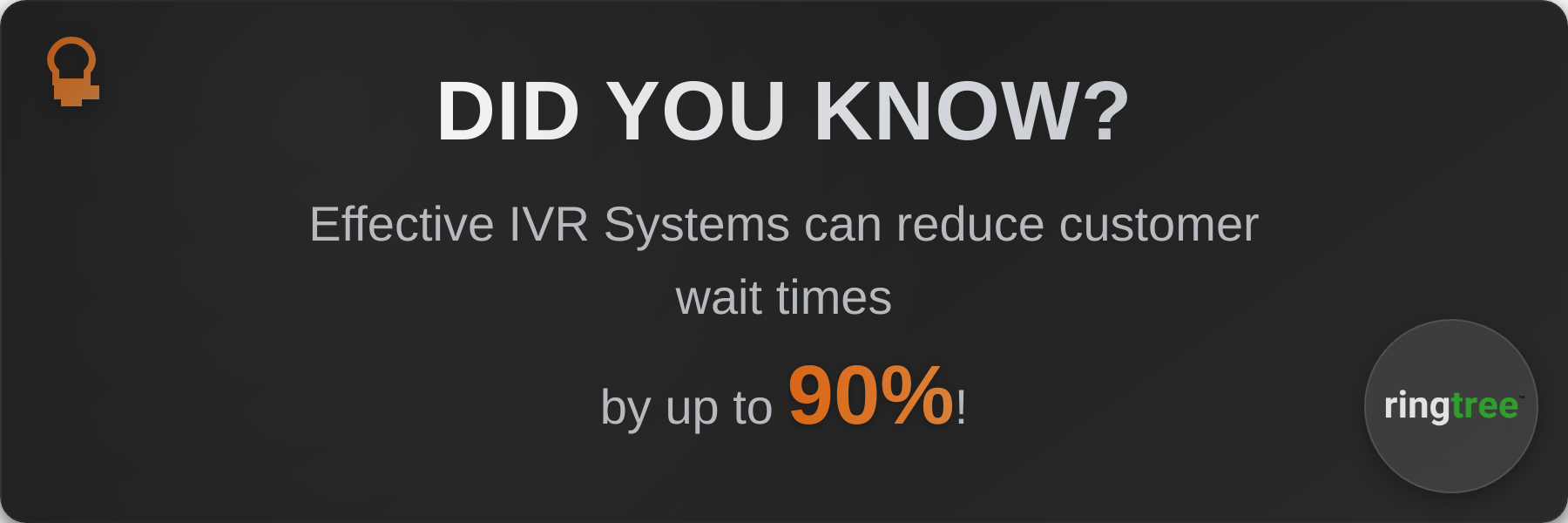Listen to this article
Introduction
What is IVR? Understanding Interactive Voice Response
An IVR system is an automated phone service tool that directs the flow of inbound communication. It typically has a pre-recorded voice that offers a series of menu options. The caller may need to press a number or state a key phrase to get successfully directed to a human agent, department answering machine, or an additional series of menu choices.
IVR systems may be simple or complex, depending on the company's size and needs. Some companies set up IVR systems to recognize a customer's phone number and use this information to access their account. Because businesses have become so accustomed to using an IVR system for its call routing ability, their flexibility and efficiency may be overlooked.
Quick IVR System Facts
Below are some interesting facts about IVR that might surprise you.
- The IVR market will see significant growth: By 2030, IVR's overall market share is expected to reach or exceed $8.3 billion.
- North America dominates IVR: Studies find that while IVR is used worldwide, North America accounts for about 40% of market growth—more than Europe and Asia combined.
- IVR drastically reduces payment processing costs: Businesses spend up to seven times more processing payments using agents than an IVR system.
- AI is streamlining IVR system technology: While legacy systems that rely on touch-tone responses are still fairly common, many services are transitioning to AI to help businesses route calls more efficiently. For instance, Ringtree offers AI-powered IVR as part of its business phone service.

8 Reasons Virtual Phone Systems Are a Budget-Saving Solution
Discover how virtual phone systems can significantly reduce costs for businesses of all sizes, from eliminating hardware expenses to enabling remote work and international operations.
Read articleHack #1: Leverage AI Technology
Over the past few years, artificial intelligence has sent progressive shockwaves across nearly every industry. AI has reduced the need for humans to perform repetitive, time-consuming tasks. In IVR, AI can recognize speech patterns to ask and answer callers' questions, efficiently directing them through a chain of options, more so than touch-tone IVR alone.
AI-infused IVR lets you professionally greet your callers and allow them to choose from a range of relevant menu options. Ringtree's AI-based IVR system is highly customizable, enabling you to choose from more than 50 voice models.
Businesses should leverage AI technology when choosing an IVR system. As the next section shows, this is not only time-saving but also great for reducing operational costs.
Hack #2: Introduce Customers to Products or Services During Holds
As callers navigate an IVR system, they often find themselves on hold, waiting to connect to a representative. Hold times vary, though you never want to keep someone waiting for too long. Research shows callers are likely to abandon the call if made to wait more than two and a half minutes. Parking customers may be unavailable, but business owners could transform this momentary inconvenience into a golden opportunity.
Businesses often use hold music to keep callers occupied, but this window of time also represents a perfect opportunity to share available products and services with potential customers. Known as "on-hold marketing," these precious seconds are a golden opportunity to capture leads and create repeat customers.
On-hold ads vary in length, though it may be best to stick to a script between 30 seconds and two minutes. You want to make sure callers get all the relevant information without having the hold period end before they know everything necessary about what you attempted to advertise!
Hack #3: Improve Services With Customer Feedback
Some companies use IVR to conduct post-call surveys, giving the caller a chance to directly communicate what they did and did not like about their experience. Likewise, you can set up an automated message directing callers to a website where they can answer additional questions meant to help you improve service quality.
Though helpful in getting direct feedback, you should know that the number of people willing to stay on the line to answer survey questions is remarkably low. One study found that response rates range between 10% and 30%. Still, there may be useful information that makes this data worth gathering. If you decide to set up a customer feedback survey using IVR, remember to:
- Keep it brief: The post-call questionnaire should consist of a few questions that are concise and easy to understand.
- Stay on topic: Keep the survey focused on the call experience and anything memorable related to it.
- Make it easy: There's no need for overly complicated questions. Instead, use a rating system between one and five or have customers answer "yes or no" questions. If you want a specific answer about their experience, remind the caller to keep it brief.
Even though post-call survey responses aren't always plentiful, these answers allow you to hear directly from your customers. Their feedback can help you understand what parts of your business phone system could be better streamlined, if hold times are too long, etc. As such, setting up some form of customer feedback through your IVR system is worth consideration.

8 Reasons Virtual Phone Systems Are a Budget-Saving Solution
Discover how virtual phone systems can significantly reduce costs for businesses of all sizes, from eliminating hardware expenses to enabling remote work and international operations.
Read articleHack #4: Cut Business Costs With IVR
Smaller businesses may use AI-powered IVR instead of live agents to save money. According to research conducted by IBM, companies using AI to lower costs can reduce expenses by 30%.
Overall, IVR and digital business phone systems let very small companies handle inbound, internal, and outbound calling with a complexity equal to traditional on-site landline structures. Voice over Internet Protocol (VoIP) and similar technology cost far less than old-school telecommunication service providers.
Want to know how much your business could save by switching to a virtual phone solution? Use our free cost-savings calculator. By comparing your number of employees and current monthly phone bill to Ringtree's rates, you may begin to see where you have been leaving money on the table that could instead get reinvested elsewhere in your business.
Hack #5: Make It a Personalized Experience
Hack #6: Cut Down on Customer Waiting Time

8 Reasons Virtual Phone Systems Are a Budget-Saving Solution
Discover how virtual phone systems can significantly reduce costs for businesses of all sizes, from eliminating hardware expenses to enabling remote work and international operations.
Read articleHack #7: Let Customers Help Themselves
Now is the Time to Make the Most of IVR
Get an AI-Powered IVR System With Ringtree
Perhaps you have been holding back on setting up an IVR system for your business because you weren't sure what it is or how to make the most of this technology. The good news is that you don't have to do it alone.
Ringtree has a wealth of articles to help you better understand how these services work. You can also directly reach out with questions about how the feature works and advice on how to get started. Ready to get started? Registration is quick and easy; you can set up your business number in as little as 60 seconds. Click here to get started!
By the Numbers
Get Started with AI-Powered IVR Today
Set up your business phone system with advanced IVR features in as little as 60 seconds.
Register NowFrequently Asked Questions
What is IVR?
Interactive voice response, or IVR, is a type of technology that lets callers choose from a series of options. Callers self-direct their calls along a series of branching choices until they arrive at a final intended destination, which might be a department or employee's office or the answer to a specific question.
What is an example of an IVR system?
An example of an IVR system is when a caller reaches an automated line and is offered a series of menu options or is encouraged to say a phrase related to the reason for their call. When a specific answer is provided, the system will then route the call to the relevant department or the next series of corresponding choices until the desired destination is reached.
How much does IVR cost?
The cost of IVR varies by service provider and pricing plan. For example, Ringtree's service plan includes AI-powered IVR at a flat monthly rate of $24.
What is the difference between call routing and IVR?
While both call routing and IVR are somewhat automated, call routing's primary purpose is to direct calls to the correct department or individual. IVR is more of a "self-help" service, as the caller provides the answer(s) necessary to determine how their call gets moved through the system.
How can I improve my interactive voice response?
You can improve your interactive voice response by ensuring the system is as efficient as possible for callers. For instance, be sure that the available menu options span the reasons customers would need to contact you; also include an "all other" option for anything not covered by standard choices. It may also be a good idea to include a voluntary survey that lets callers provide feedback regarding what they did or did not like about your IVR system.
How to Get a Business Phone Number on Your Cell Phone
Need help adding a professional number to your phone? Here's everything you need to know about getting a business phone number on your cell phone, step by step!
Is This a Legitimate Number? 5 Signs You're Dealing With a S...
Scammer phone numbers are a growing problem. As potential victims search for answers, we offer key ways to protect yourself and your business from fraudulent calls.

8 Reasons Virtual Phone Systems Are a Budget-Saving Solution
Discover how virtual phone systems can significantly reduce costs for businesses of all sizes, from eliminating hardware expenses to enabling remote work and international operations.


